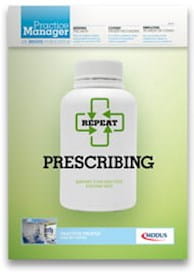ONE area of indisputable risk within general practice is the management of repeat prescribing systems. Most practices have evolved a system which is heavily reliant on both their patient IT system and the human-user interface. All will have certain strengths and risks and when they fail can result in harm to the patient and the possibility of a complaint or claim of negligence.
A recent study commissioned by the GMC looking at prescribing or monitoring errors within general practice found they occurred in one in every 20 prescription items. They found the errors could be attributed both to the prescriber or the patient, the team, the working environment, the task, the computer system and the primary–secondary care interface.
The role of the practice manager is essential in ensuring that repeat prescribing systems are robust. Safe repeat prescribing can be achieved where everyone involved (patients, receptionists, GPs, practice nurses) understands the importance of their role, the associated risks and how each impacts on the other. In addition, it is important that information is accurately recorded within the patient system, and that there are regular and prompted clinical reviews of each prescribing record. Training on consistent use of the patient system and effective team-working are crucial to support patient safety.
Although each practice will have their own systems in place, and each will be different, MDDUS sees patterns associated within claims of negligence each year where systems have failed and contributed to patient harm. These patterns highlight often avoidable risk and are discussed below.
LACK OF MONITORING
Past or acute medication requests
There are often clinical reasons informing a GP’s decision not to add an item to a patient’s repeat prescribing record, and any requests from patients for an item which is not available on the record should be treated differently. The system should ensure that the GP is notified when items are not on repeat and this should prompt an active decision to re-authorise the item. This lack of a prompt is compounded when a practice delegates responsibility to non-clinical staff for preparation of the prescription for signing. Failure here can result in the patient receiving medication for too long without clinical review.
System output information
The clinical team should work to ensure that all new repeat prescription items are added accurately, taking into account the nature of the medication, how it is to be used and how often it should be reviewed. Any new drugs should be added into the context of the whole picture, which should result in more e§- cient management of each patient’s repeat prescriptions. Time taken in this initial stage will ensure that the patient system delivers useful information at the time of prescription preparation, such as warnings of possible non-compliance or overuse of items, as well as prompts for necessary re-authorisation of items.
Where consistency is not applied in item entry, or where the task of adding items is delegated to a non-clinical team member, practices are likely to receive a high number of ‘useless’ or inaccurate prompts from the patient system. This can result in these being ignored by the team. In investigation of any failure of repeat monitoring, the practice will certainly be asked why they did not use the patient system in a reasonable, eective way to ensure patient safety.
CONTRAINDICATIONS AND INTERACTIONS
MDDUS often assists practices with claims of negligence where patients have been harmed by a missed interaction, missed contraindication or incorrect prescription. These are often avoidable if information is coded correctly within patient systems, where there is a clinical overview of any additions or changes to repeat medication records, or if safety prompts are added into clinical decision-making.
Reconciliation of discharge medication
There is a substantial body of evidence to indicate that risks associated with moving between sectors contribute directly to patient harm. In 2010, the Department of Health reported that 30-70 per cent of patients experience a medication error when their care is transferred. Often discharges are illegible and include complex changes to a patient’s prescribing regime. A Royal Pharmaceutical Report earlier this year found that the likelihood of an elderly patient leaving hospital on the same medicines that they were admitted on is less than 10 per cent*. In addition, between 28-40 per cent of medicines are discontinued and 45 per cent of medicines are new at discharge, and 60 per cent of patients have three or more medicines changed during their stay in hospital.
Where the practice system includes both a clinical overview and an actioning of changes, the risk of error is likely to be significantly reduced. Although it is possible that clinicians may still be liable to make an error, the risk is reduced with clinical understanding. If any responsibility is delegated to non-clinical staff, doctors should ensure they are competent to undertake the task, understand the associated risks and always check and ‘sign-off’ the nal repeat record.
Prescribing where known allergy exists
Each year, patients suffer harm when they are prescribed a drug to which they have a known allergy. Most patient systems now incorporate the capacity to code known allergies such that an automated safety prompt is triggered when a drug is prescribed. This is a useful safety net available to practices and should be used in addition to normal advice which is always to ask the patient if they have an allergy.
Accurate clinical coding of a patient’s conditions and a comprehensive record of prescribing are essential to ensure appropriate safety prompts are activated when a patient’s condition or other drugs might suggest a problem. Any non-clinical staff delegated responsibility for coding should be fully trained and understand the importance of this role.
UNCOLLECTED PRESCRIPTIONS
Repeats
The fact that a patient has requested but not collected a repeat prescription can provide useful information about their compliance. In most practices, the receptionists check the ‘prescription box’ every couple of months for old prescriptions. These are often destroyed without action. In order to ensure the repeat prescription record is accurate, the items should be recorded as ‘uncollected’ and the prescriptions destroyed. This ensures that any automated prompts on prescriptions are accurate and alerts doctors to possible nonor under-compliance at the patient’s regular repeat medication review.
Acutes
Negligence claims consistently arise when a patient’s treatment has been unnecessarily delayed. This sometimes can be a result of maladministration of prescriptions awaiting collection. Where a GP has taken a clinical decision to prescribe an acute drug, it is important to ensure that the patient receives it. If any acute prescriptions remain for collection after an agreed time period, they should be reviewed by a clinician to agree whether further action is required, and the patient prescribing record updated – particularly if it is decided that the prescription is no longer required.
DEVELOPING A ROBUST SYSTEM
When reviewing your own practice system it is important to map out the processes in place and review whether there are any areas that could be improved. It is also important to understand how your own patient system functions and the safety features and prompts available to you should you use it fully. Ensuring competency, consistency and accuracy when entering clinical conditions and new items into patient prescribing records is critical to trigger appropriate safety information.
Practice managers should assess along with the partners who is most appropriately skilled and experienced to carry out each process in order that patient safety is supported. Further, practice managers should ensure that the practice culture values patient safety, that workload and stress are assessed and managed and that distractions and interruptions for individuals carrying out processes around repeat prescribing are minimised. This is supported by the conclusions reached by the recent GMC study.
MDDUS ASSISTANCE
If you are concerned about your practice system and would like assistance with risk assessment, please don’t hesitate to contact one of our Training and Risk Advisory team at risk@mddus.com
Liz Price is the training and consultancy services manager at MDDUS
* Quoted in a Royal Pharmaceutical Society Report 2011 from Department of Health ‘The NHS Outcomes Framework 2011/12’
This page was correct at the time of publication. Any guidance is intended as general guidance for members only. If you are a member and need specific advice relating to your own circumstances, please contact one of our advisers.
Read more from this issue of Practice Manager

Save this article
Save this article to a list of favourite articles which members can access in their account.
Save to library


